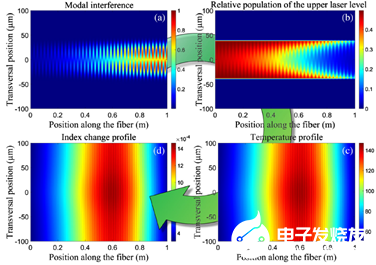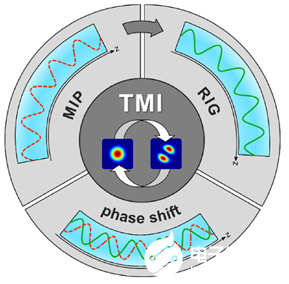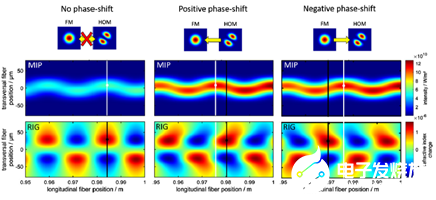10월 26, 2020
2092
Since Mayman built the first laser in 1960, the laser has had a wide range of influences in the fields of medicine, industry, and science. After 60 years of development, new laser technologies and applications are still emerging, and fiber lasers are a typical representative. The advantage of optical fiber not only stems from its slender geometry, but also because it is the only high-power active medium with a waveguide structure that can produce diffraction-limited beams. In the active fiber, the heat is dispersed in the radial direction, so that the fiber laser can operate under a high thermal load and generate a very high average power.
In order to avoid the harmful effects of non-linear effects (such as Raman and Brillouin scattering, self-phase modulation and self-focusing effects) in the fiber on the laser performance, large-mode field fibers have emerged as the times require, and they have quickly become a problem for building high-power fiber lasers. The second choice. As the average power increases, the thermal load of the active fiber rises sharply. While the thermal effect reduces the mode field area, it also causes the headache of Transverse mode instability (TMI). Specifically, TMI means that after the average power exceeds a certain threshold, the beam quality and stability of the fiber laser will suddenly decrease. The TMI threshold is usually between 100 W and several kilowatts (KW). Different from other known nonlinear effects in fiber laser systems, TMI has become the main bottleneck restricting the further increase of the average power of fiber lasers. In 2010, the Jena research group first reported the TMI phenomenon, which subsequently attracted widespread attention and has become a hot spot in fiber laser research in recent years.
Regarding the TMI phenomenon, the currently accepted conclusions include:
TMI originates from thermal effects and has nothing to do with doped ions. TMI will appear when any laser system (such as thulium-doped fiber laser) reaches a certain average power. There is a transition zone between the steady state of the beam (below the TMI threshold) and the typical unstable phase (above the TMI threshold), which is characterized by periodic beam fluctuations. The beam fluctuates on the millisecond scale, and the beam is a coherent superposition of two or more transverse modes at any time. When the average power is much higher than the TMI threshold, as the average output power increases, more and more transverse modes participate in the beam fluctuations, and the beam is generally close to the super-Gaussian distribution (flat top shape).

figure 1. Four-step model of thermally induced RIG generation in optical fiber
When the average output power of the fiber laser exceeds the TMI threshold, energy transfer occurs between different transverse modes in the fiber, and this energy transfer requires phase matching. Long-period grating (LPG) is an optical structure that allows energy exchange between different transverse modes in an optical fiber. Its internal refractive index has a periodic (quasi-periodic) distribution, and the period is significantly longer than the laser wavelength. In order to meet the energy transfer conditions between different transverse modes, the periodicity and symmetry of the refractive index changes in LPG must be similar to the inter-mode interference pattern (MIP) produced by these transverse modes. At present, it is widely accepted that the generation of LPG in optical fiber is caused by heat accumulation. The cause of thermally induced LPG is explained with reference to Figure 1 above: when light is coupled into a large-core fiber, most of the energy flows into the fundamental mode, and a small part flows into the first higher-order mode. The difference of the phase velocities of different transverse modes in the fiber leads to the generation of MIP, which makes the optical field in the core present a quasi-periodic distribution of alternating strong and weak. Compared with the weak light field, the number of inverted particles in the strong light field area is depleted faster, so the quasi-periodical distribution of the light field will cause the number of inverted particles to show a laterally uneven quasi-periodic distribution. The change in the number of reversal populations will affect the power amplification and energy extraction capabilities, and subsequently will produce a laterally uneven quasi-periodical temperature field. The difference in temperature distribution will generate a quasi-periodical refractive index grating under the influence of the thermo-optic effect. This is the process of generating a thermally induced refractive index grating (RIG) in an optical fiber.

figure 2. Basic physical picture of TMI phenomenon
In addition, energy transfer between different transverse modes also requires a phase shift between MIP and RIG, as shown in Figure 2. At present, the cause of the phase shift between MIP and RIG is still undecided. One theory is that different transverse modes have different center frequencies, which results in changing MIP. The phase shift between MIP and RIG exists at low power, but only at high power can there be a significant energy transfer process. The source of the difference in center frequency in this statement cannot be explained, and it is contradictory to some experimental results. Another argument is that there is no center frequency difference between the transverse modes, and the MIP produced is quasi-static. The sensitivity of the energy transfer between modes to the phase shift will increase with the increase of the average power, showing an exponential upward trend. Because when the average power increases, the corresponding RIG is also enhanced. With a sufficiently strong RIG, even a small phase shift caused by the inherent noise of the system will cause a strong energy transfer. Although both theories have corresponding simulation calculations, only the second statement has calculated results that are more realistic and contain more information about the real physical mechanism behind TMI.

image 3. The influence of the phase shift between MIP and RIG on the energy transfer between transverse modes
Although the cause of the phase shift between MIP and RIG is still controversial, the influence mechanism of this phase shift on the TMI process is very clear, as shown in Figure 3. The sign of the phase shift determines the direction of energy transfer between modes: when the phase shift is positive, the energy flows from the higher-order mode to the fundamental mode; when the phase shift is negative, the energy flows from the fundamental mode to the higher-order mode; if the phase is consistent, there is no energy flow. In the light beam fluctuation period of the TMI phenomenon, the sign and magnitude of the phase shift are changing with time, so the energy flow direction is also changing with time.

Figure 4. Schematic diagram of the effect of thermal load on the effective refractive index difference between transverse modes
Studies have shown that changes in pump power will produce this phase shift. As shown in Figure 4, an increase in pump power will cause an axial temperature gradient in the fiber core, and an axial refractive index gradient will be generated under the influence of thermo-optic effects, which will eventually make the effective refractive index difference between the fundamental mode and the higher-order mode Get bigger. The period of the MIP is inversely proportional to the effective refractive index difference between the fundamental mode and the higher-order mode. Therefore, the large refractive index difference makes the MIP compressed, which is an instant response to temperature changes. In contrast, it takes a certain time for RIG to change from the previous state to the next state, and this hysteresis will produce a positive phase shift between MIP and RIG.
For thermally induced TMI, the most important factor is the thermal load in the optical fiber. The main heat sources in optical fibers include quantum defects and photon darkening. Both of them generate corresponding thermal RIGs through thermal effects, which are superimposed on each other, resulting in a decrease in the TMI threshold. Through technological improvements, the current photon darkening loss in optical fibers can be reduced to a very low level, but compared to quantum defects, photon darkening converts all absorbed pump and signal photons into heat, so it is still an important factor affecting TMI .
In short, TMI not only depends on fiber parameters, but also related to the operating state of the entire fiber amplifier. Pump mode, pump light and signal light wavelength, relative intensity noise of pump and seed light, etc., will have a significant impact on the TMI threshold.